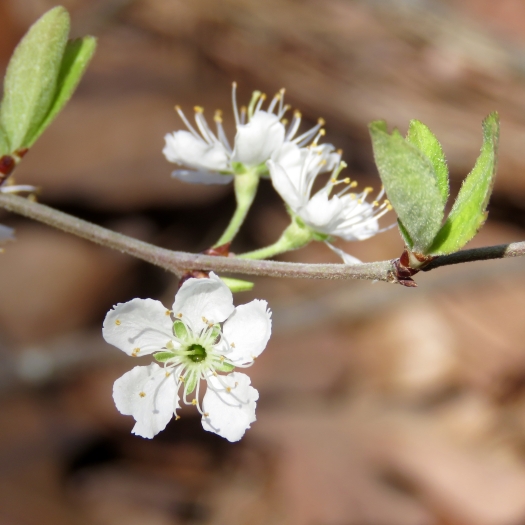Oklahoma Plum
(Prunus gracilis)
Oklahoma Plum (Prunus gracilis)
/
/

Laura Clark
CC BY 4.0
Image By:
Laura Clark
Recorded By:
Copyright:
CC BY 4.0
Copyright Notice:
Photo by: Laura Clark | License Type: CC BY 4.0 | License URL: http://creativecommons.org/licenses/by/4.0/ | Rights Holder: Laura Clark | Publisher: iNaturalist | Date Created: 2017-03-08T12:51:16-08:00 |














Estimated Native Range
Summary
Prunus gracilis, commonly known as Oklahoma Plum, is a deciduous shrub native to the prairies, open woodlands, and savannas of the Central United States. It typically grows to a height of 4-6 feet (1.2-1.8 meters) and a width of 2-3 feet (0.6-0.9 meters). The plant has a rounded form and produces clusters of showy white flowers in the spring, which are followed by small, red to yellow plums that are attractive to wildlife. The bark is dark and can become scaly with age, adding winter interest to the landscape.
Oklahoma Plum is valued for its hardiness and drought tolerance, making it an excellent choice for low-maintenance naturalistic plantings. It is often used in native plant gardens, as a border shrub, or for erosion control on slopes. This shrub thrives in full sun to partial shade and prefers well-drained soils, although it can adapt to various soil types. While generally disease-resistant, it can be susceptible to pests such as aphids and borers. Oklahoma Plum is not known for aggressive roots or significant disease problems, but it can spread by suckering, which may require management in a garden setting.CC BY-SA 4.0
Oklahoma Plum is valued for its hardiness and drought tolerance, making it an excellent choice for low-maintenance naturalistic plantings. It is often used in native plant gardens, as a border shrub, or for erosion control on slopes. This shrub thrives in full sun to partial shade and prefers well-drained soils, although it can adapt to various soil types. While generally disease-resistant, it can be susceptible to pests such as aphids and borers. Oklahoma Plum is not known for aggressive roots or significant disease problems, but it can spread by suckering, which may require management in a garden setting.CC BY-SA 4.0
Plant Description
- Plant Type: Shrub
- Height: 4-6 feet
- Width: 2-3 feet
- Growth Rate: Moderate
- Flower Color: White
- Flowering Season: Spring
- Leaf Retention: Deciduous
Growth Requirements
- Sun: Full Sun
- Water: Low
- Drainage: Medium, Fast
Common Uses
Bee Garden, Bird Garden, Butterfly Garden, Edible*Disclaimer: Easyscape's listed plant edibility is for informational use. Always verify the safety and proper identification of any plant before consumption., Fragrant, Low Maintenance, Rabbit Resistant, Showy Flowers
Natural Habitat
Prairies, open woodlands, and savannas of the Central United States
Other Names
Common Names: Sour Plum, Sand Plum
Scientific Names: , Prunus gracilis, Prunus normalis,
GBIF Accepted Name: Prunus gracilis Engelm. & Gray